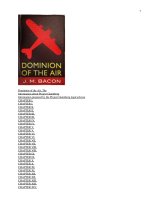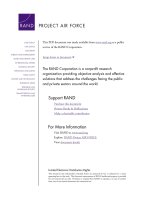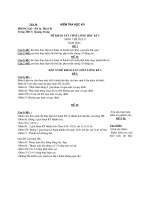- Trang chủ >>
- THPT Quốc Gia >>
- Hóa
Glencoe science module i the air around you mcgraw hill 2005
Bạn đang xem bản rút gọn của tài liệu. Xem và tải ngay bản đầy đủ của tài liệu tại đây (20.93 MB, 188 trang )
i-01-LBI-861758
8/23/04
3:19 PM
Page i
NASA/Science Photo Library/Photo Researchers
i-01-LBI-861758
8/23/04
3:20 PM
Page ii
The Air Around You
This satellite image shows
Hurricane Bonnie, which
struck North Carolina in 1998.
The storm was nearly 400 miles
wide, with the highest recorded
wind gust at 104 mph. Overall
damages were estimated in the
$1.0 billion dollar range, and
three deaths were attributed to
the Category 3 storm.
Copyright © 2005 by The McGraw-Hill Companies, Inc. All rights reserved. Except as permitted under
the United States Copyright Act, no part of this publication may be reproduced or distributed in any
form or by any means, or stored in a database or retrieval system, without prior written permission
of the publisher.
The National Geographic features were designed and developed by the National Geographic Society’s
Education Division. Copyright © National Geographic Society.The name “National Geographic Society”
and the Yellow Border Rectangle are trademarks of the Society, and their use, without prior written
permission, is strictly prohibited.
The “Science and Society” and the “Science and History” features that appear in this book were
designed and developed by TIME School Publishing, a division of TIME Magazine.TIME and the red
border are trademarks of Time Inc. All rights reserved.
Send all inquiries to:
Glencoe/McGraw-Hill
8787 Orion Place
Columbus, OH 43240-4027
ISBN: 0-07-861758-8
Printed in the United States of America.
2 3 4 5 6 7 8 9 10 027/043 09 08 07 06 05 04
NASA/Science Photo Library/Photo Researchers
i-01-LBI-861758
8/23/04
3:20 PM
Page iii
Authors
Education Division
Washington, D.C.
Susan Leach Snyder
Dinah Zike
Earth Science Teacher, Consultant
Jones Middle School
Upper Arlington, OH
Educational Consultant
Dinah-Might Activities, Inc.
San Antonio, TX
Series Consultants
CONTENT
READING
ACTIVITY TESTERS
William C. Keel, PhD
Carol A. Senf, PhD
Nerma Coats Henderson
Department of Physics and
Astronomy
University of Alabama
Tuscaloosa, AL
School of Literature,
Communication, and Culture
Georgia Institute of Technology
Atlanta, GA
Pickerington Lakeview Jr. High
School
Pickerington, OH
MATH
SAFETY
Teri Willard, EdD
Aileen Duc, PhD
Mathematics Curriculum Writer
Belgrade, MT
Science 8 Teacher
Hendrick Middle School, Plano ISD
Plano, TX
Mary Helen Mariscal-Cholka
William D. Slider Middle School
El Paso, TX
Science Kit and Boreal
Laboratories
Tonawanda, NY
Series Reviewers
Lois Burdette
Nerma Coats Henderson
Sharon Mitchell
Green Bank Elementary-Middle
School
Green Bank, WV
Pickerington Lakeview Jr. High
School
Pickerington, OH
William D. Slider Middle School
El Paso, TX
Marcia Chackan
Michael Mansour
Pine Crest School
Boca Raton, FL
Board Member
National Middle Level Science
Teacher’s Association
John Page Middle School
Madison Heights, MI
Pioneer Jr-Sr. High School
Royal Center, IN
Annette D’Urso Garcia
Kearney Middle School
Commerce City, CO
Mark Sailer
Kate Ziegler
Durant Road Middle School
Raleigh, NC
I
◆
iii
i-01-LBI-861758
8/23/04
3:20 PM
Page iv
Why do I need
my science book?
Have you ever been in class and
not understood all of what was
presented? Or, you understood
everything in class, but at home,
got stuck on how to answer a
question? Maybe you just
wondered when you were ever
going to use this stuff?
These next few pages
are designed to help you
understand everything your
science book can be used
for . . . besides a paperweight!
Before You Read
●
Chapter Opener Science is occurring all around you,
and the opening photo of each chapter will preview the
science you will be learning about. The Chapter
Preview will give you an idea of what you will be
learning about, and you can try the Launch Lab to
help get your brain headed in the right direction. The
Foldables exercise is a fun way to keep you organized.
●
Section Opener Chapters are divided into two to four
sections. The As You Read in the margin of the first
page of each section will let you know what is most
important in the section. It is divided into four parts.
What You’ll Learn will tell you the major topics you
will be covering. Why It’s Important will remind you
why you are studying this in the first place! The
Review Vocabulary word is a word you already know,
either from your science studies or your prior knowledge. The New Vocabulary words are words that you
need to learn to understand this section. These words
will be in boldfaced print and highlighted in the
section. Make a note to yourself to recognize these
words as you are reading the section.
(bkgd)John Evans, (inset)NASA/Science Photo Library/Photo Researchers
i-01-LBI-861758
8/23/04
3:20 PM
Page v
Science Vocabulary Make the
following Foldable to help you
understand the vocabulary
terms in this chapter.
As You Read
●
Headings Each section has a title
in large red letters, and is further
divided into blue titles and
small red titles at the beginnings of some paragraphs.
To help you study, make an
outline of the headings and
subheadings.
Margins In the margins of
your text, you will find many helpful
resources. The Science Online exercises and
Integrate activities help you explore the topics
you are studying. MiniLabs reinforce the science concepts you have learned.
●
●
Building Skills You also will find an
Applying Math or Applying Science activity
in each chapter. This gives you extra practice using your new knowledge, and helps
prepare you for standardized tests.
●
Student Resources At the end of the book
you will find Student Resources to help you
throughout your studies. These include
Science, Technology, and Math Skill Handbooks, an English/Spanish Glossary, and an
Index. Also, use your Foldables as a resource.
It will help you organize information, and
review before a test.
●
In Class Remember, you can always
ask your teacher to explain anything
you don’t understand.
STEP 1 Fold a vertical
sheet of notebook
paper from side to
side.
STEP 2 Cut along every third line of only the
top layer to form tabs.
STEP 3 Label each tab with a vocabulary
word from the chapter.
Build Vocabulary As you read the chapter, list
the vocabulary words on the tabs. As you learn
the definitions, write them under the tab for
each vocabulary word.
Look For...
At the beginning of
every section.
I
◆
v
(t)PhotoDisc, (b)John Evans
i-01-LBI-861758
8/23/04
3:20 PM
Page vi
In Lab
Working in the laboratory is one of the best ways to understand the concepts you are studying. Your book will be your guide through your laboratory
experiences, and help you begin to think like a scientist. In it, you not only will
find the steps necessary to follow the investigations, but you also will find
helpful tips to make the most of your time.
●
Each lab provides you with a Real-World Question to remind you that
science is something you use every day, not just in class. This may lead
to many more questions about how things happen in your world.
●
Remember, experiments do not always produce the result you expect.
Scientists have made many discoveries based on investigations with unexpected results. You can try the experiment again to make sure your results
were accurate, or perhaps form a new hypothesis to test.
●
Keeping a Science Journal is how scientists keep accurate records of observations and data. In your journal, you also can write any questions that
may arise during your investigation. This is a great method of reminding
yourself to find the answers later.
r... ery chapter.
o
F
k
o
o
L h Labs start ev ach
e
Launc
argin of
m
e
h
t
iLabs in
● Min
ery
chapter.
abs in ev
L
d
o
i
r
e
Full-P
● Two
e
abs at th
chapter.
L
e
m
o
H
A Try at .
● EXTR
o
ur b ok
y
end of yo
borator
a
l
h
it
w
eb site s.
● the W
tration
demons
●
vi
◆
I
(l)John Evans, (r)Geoff Butler
i-01-LBI-861758
8/23/04
3:20 PM
Page vii
Before a Test
Admit it! You don’t like to take tests! However, there are
ways to review that make them less painful. Your book will
help you be more successful taking tests if you use the
resources provided to you.
●
Review all of the New Vocabulary words and be sure you
understand their definitions.
●
Review the notes you’ve taken on your Foldables, in class,
and in lab. Write down any question that you still need
answered.
●
Review the Summaries and Self Check questions at the
end of each section.
●
Study the concepts presented in the chapter by reading
the Study Guide and answering the questions in
the Chapter Review.
Look For...
●
●
●
●
Reading Checks and caption
questions throughout the text.
the Summaries and Self Check
questions at the end of each section.
the Study Guide and Review
at the end of each chapter.
the Standardized Test Practice
after each chapter.
I
◆
vii
(l)John Evans, (r)PhotoDisc
i-01-LBI-861758
8/23/04
3:20 PM
Page viii
Let’s Get Started
To help you find the information you need quickly, use the Scavenger
Hunt below to learn where things are located in Chapter 1.
What is the title of this chapter?
What will you learn in Section 1?
Sometimes you may ask, “Why am I learning this?” State a reason why the
concepts from Section 2 are important.
What is the main topic presented in Section 2?
How many reading checks are in Section 1?
What is the Web address where you can find extra information?
What is the main heading above the sixth paragraph in Section 2?
There is an integration with another subject mentioned in one of the margins
of the chapter. What subject is it?
List the new vocabulary words presented in Section 2.
List the safety symbols presented in the first Lab.
Where would you find a Self Check to be sure you understand the section?
Suppose you’re doing the Self Check and you have a question about concept
mapping. Where could you find help?
On what pages are the Chapter Study Guide and Chapter Review?
Look in the Table of Contents to find out on which page Section 2 of the
chapter begins.
You complete the Chapter Review to study for your chapter test.
Where could you find another quiz for more practice?
viii
PhotoDisc
◆
I
i-01-LBI-861758
8/23/04
3:20 PM
Page ix
Teacher Advisory Board
he Teacher Advisory Board gave the editorial staff and design team feedback on the
content and design of the Student Edition. They provided valuable input in the development of the 2005 edition of Glencoe Science.
T
John Gonzales
Challenger Middle School
Tucson, AZ
Marie Renner
Diley Middle School
Pickerington, OH
Rubidel Peoples
Meacham Middle School
Fort Worth, TX
Rachel Shively
Aptakisic Jr. High School
Buffalo Grove, IL
Nelson Farrier
Hamlin Middle School
Springfield, OR
Kristi Ramsey
Navasota Jr. High School
Navasota, TX
Roger Pratt
Manistique High School
Manistique, MI
Jeff Remington
Palmyra Middle School
Palmyra, PA
Kirtina Hile
Northmor Jr. High/High School
Galion, OH
Erin Peters
Williamsburg Middle School
Arlington, VA
Student Advisory Board
he Student Advisory Board gave the editorial staff and design team feedback on the
design of the Student Edition. We thank these students for their hard work and
creative suggestions in making the 2005 edition of Glencoe Science student friendly.
T
Jack Andrews
Reynoldsburg Jr. High School
Reynoldsburg, OH
Addison Owen
Davis Middle School
Dublin, OH
Peter Arnold
Hastings Middle School
Upper Arlington, OH
Teriana Patrick
Eastmoor Middle School
Columbus, OH
Emily Barbe
Perry Middle School
Worthington, OH
Ashley Ruz
Karrar Middle School
Dublin, OH
Kirsty Bateman
Hilliard Heritage Middle School
Hilliard, OH
Andre Brown
Spanish Emersion Academy
Columbus, OH
Chris Dundon
Heritage Middle School
Westerville, OH
Ryan Manafee
Monroe Middle School
Columbus, OH
The Glencoe middle school science Student
Advisory Board taking a timeout at COSI,
a science museum in Columbus, Ohio.
I
◆
ix
Aaron Haupt Photography
i-01-LBI-861758
8/23/04
3:21 PM
Page x
Contents
Contents
Nature of Science:
Storm Scientists—2
Atmosphere—6
Section 1
Section 2
Section 3
Earth’s Atmosphere . . . . . . . . . . . . . . . . . . . . . . . . . .8
Lab Evaluating Sunscreens . . . . . . . . . . . . . . . . . . .16
Energy Transfer in the Atmosphere . . . . . . . . . . .17
Air Movement . . . . . . . . . . . . . . . . . . . . . . . . . . . . .21
Lab: Design Your Own
The Heat is On . . . . . . . . . . . . . . . . . . . . . . . . . . .26
Weather—34
Section 1
Section 2
Section 3
What is weather? . . . . . . . . . . . . . . . . . . . . . . . . . . .36
Weather Patterns . . . . . . . . . . . . . . . . . . . . . . . . . . .44
Weather Forecasts . . . . . . . . . . . . . . . . . . . . . . . . . .52
Lab Reading a Weather Map . . . . . . . . . . . . . . . . .55
Lab: Model and Invent
Measuring Wind Speed . . . . . . . . . . . . . . . . . . . .56
Climate—64
Section 1
Section 2
Section 3
x
◆
I
Roy Johnson/Tom Stack & Assoc.
What is climate? . . . . . . .66
Climate Types . . . . . . . . .70
Climatic Changes . . . . . .74
Lab The Greenhouse
Effect . . . . . . . . . . . . . .85
Lab Microclimates . . . . .86
In each chapter, look for
these opportunities for
review and assessment:
• Reading Checks
• Caption Questions
• Section Review
• Chapter Study Guide
• Chapter Review
• Standardized Test
Practice
• Online practice at
booki.msscience.com
i-01-LBI-861758
8/23/04
3:21 PM
Page xi
Contents
Contents
Air Pollution—94
Section 1
Section 2
Section 3
Types and Causes of
Air Pollution . . . . . . . .96
Lab Particulate
Pollution . . . . . . . . . . .103
Effects of Air
Pollution . . . . . . . . . .104
Solutions to Air
Pollution . . . . . . . . . .111
Lab: Use the Internet
Air Pollution Where
You Live . . . . . . . . . . .116
Student Resources
Science Skill Handbook—126
Scientific Methods . . . . . . . . . . .126
Safety Symbols . . . . . . . . . . . . . .135
Safety in the Science
Laboratory . . . . . . . . . . . . . . .136
Extra Try at Home Labs—138
Technology Skill
Handbook—140
Computer Skills . . . . . . . . . . . . .140
Presentation Skills . . . . . . . . . . .143
Math Skill Handbook—144
Reference Handbooks—159
Weather Map Symbols . . . . . . . . .159
Minerals . . . . . . . . . . . . . . . . . . . .160
Rocks . . . . . . . . . . . . . . . . . . . . . .162
Topographic Map Symbols . . . .163
Periodic Table of
the Elements . . . . . . . . . . . . . .164
English/Spanish
Glossary—166
Index—172
Cedits—176
Math Review . . . . . . . . . . . . . . . .144
Science Applications . . . . . . . . .154
I
◆
xi
Holger Weitzel/CORBIS
i-01-LBI-861758
8/23/04
3:21 PM
Page xii
Cross-Curricular Readings/Labs
available as a video lab
VISUALIZING
Content Details
1
2
3
4
Global Winds . . . . . . . . . . . . . . . . . 23
Tornadoes . . . . . . . . . . . . . . . . . . . . 49
El Niño and La Niña.. . . . . . . . 76–77
Emissions Control . . . . . . . . . . . . 113
2 Rainmakers . . . . . . . . . . . . . . . . . . . 58
3 The Year There Was No
Summer. . . . . . . . . . . . . . . . . . . . 88
Accidents
1
2
3
4
Modeling Heat Transfer . . . . . . . . 19
Measuring Rain . . . . . . . . . . . . . . . 53
Modeling El Niño . . . . . . . . . . . . . 75
Observing Particulates. . . . . . . . . 100
in SCIENCE
4 Radon: The Invisible Threat . . . . 118
1 Song of the Sky Loom . . . . . . . . . . 28
1
2
3
4
Observe Air Pressure . . . . . . . . . . . . 7
What causes rain?. . . . . . . . . . . . . . 35
Tracking World Climates. . . . . . . . 65
Acid in Air . . . . . . . . . . . . . . . . . . . 95
One-Page Labs
1
2
3
4
Evaluating Sunscreens . . . . . . . . . . 16
Reading a Weather Map . . . . . . . . 55
The Greenhouse Effect . . . . . . . . . 85
Particulate Pollution . . . . . . . . . . 103
Two-Page Labs
3 Microclimates. . . . . . . . . . . . . . 86–87
Design Your Own Labs
1 The Heat Is On. . . . . . . . . . . . . 26–27
1
2
3
4
xii
◆
Determining if Air Has Mass . . . . 13
Determining Dew Point . . . . . . . . 38
Observing Solar Radiation . . . . . . 67
Modeling Ozone Depletion . . . . 106
I
Roy Morsch/The Stock Market/CORBIS
Model and Invent Labs
2 Measuring Wind Speed . . . . . . 56–57
i-01-LBI-861758
8/23/04
3:21 PM
Page 1
Labs/Activities
Use the Internet Labs
4 Air Pollution Where
You Live . . . . . . . . . . . . . . 116–117
Applying Math
Applying Science
1 How does altitude affect
air pressure? . . . . . . . . . . . . . . . . 12
3 How do cities influence
temperature? . . . . . . . . . . . . . . . .68
Content Details
2 Dew Point . . . . . . . . . . . . . . . . . . . . 39
4 Burning Coal . . . . . . . . . . . . . . . . 114
Career: 79
Environment: 50
Health: 15, 105
Life Science: 14, 37, 71
Physics: 18, 45, 68, 98
Social Studies: 97
10, 22, 45, 48, 81, 83, 101, 112
Standardized Test Practice
32–33, 62–63, 92–93, 122–123
I
◆
1
David Weintraub/Stock Boston
02-05-LBI-NOS-861758
8/23/04
2:58 PM
Page 2
Experimentation
Storm
Scientists
H
urricanes are among nature’s most destructive
forces. These storms, which have lasting wind
speeds of at least 120 km/h, can flatten trees,
destroy houses, and kill people. Satellite images of
hurricanes help scientists estimate when, where, and with how
much force a storm will strike. However, researchers sometimes need detailed information about the internal
structure of a hurricane that satellites can’t provide.
To collect such information, daring scientists fly
airplanes where no other travelers dare—directly
into the strongest winds of a hurricane.
To measure the fury of a hurricane, researchers
must punch through the eye wall—a swirling wall
of clouds with high winds surrounding the eye.
Sometimes the clouds are so thick in the eye wall
that the crew can’t see the airplane’s wings.
Figure 1 The roof was ripped
off this home in Hawaii by the
powerful winds of a hurricane.
Figure 2 Scientists use aircraft
fitted with high-tech measuring
devices to fly into hurricanes and
collect data.
2
◆
I
Storm Scientists
(t)Galen Rowell/Corbis, (b)Jeffrey Howe/Visuals Unlimited
02-05-LBI-NOS-861758
8/23/04
2:58 PM
Page 3
Gathering Information
Researchers who fly into hurricanes are
blinded by rain. Powerful winds can send the
aircraft plummeting to Earth. Despite these
dangers, scientists continue to make measurements that require flying into hurricanes.
The NOAA (National Oceanic and
Atmospheric Administration) maintains special
planes fitted with wind probes and other
devices to collect data from hurricanes. These
planes fly at maximum and minimum elevations of 6,000 m and 450 m. The low-altitude
flying is particularly dangerous because there is
little room for recovery if a plane loses control.
While flying through hurricanes, scientists
sometimes release dropsondes, which are small
devices that parachute down through a storm
taking measurements such as temperature,
pressure, wind direction, and humidity.
These data are used in computer models that predict
how intense a hurricane is and where it might reach land.
The models, in turn, are used to issue watches, warnings,
and forecasts to minimize destruction of property and
loss of life.
Figure 3 Dropsondes released
from aircraft collect information
as they fall through a hurricane.
Figure 4 Hurricane Georges
wreaked havoc in Key West,
Florida, in 1998.
THE NATURE OF SCIENCE
I
◆
3
(t)Poav Levy/PhotoTake NYC/PictureQuest, (b)AP/Wide World Photos/Dave Martin
02-05-LBI-NOS-861758
8/23/04
2:58 PM
Page 4
The Study of Weather
Meteorologists are scientists who study weather and make
predictions. Meteorologists make weather forecasts using data
collected from measurements and observations. Forecasting
the strength and movement of hurricanes becomes more accurate if data are collected from many regions.
Even when flying into the eye of a hurricane, researchers
must use scientific methods and make accurate observations to
make predictions about a storm’s strength and direction. Many
of these data are gathered by performing a variety of sophisticated investigations, or experiments.
Experimentation
Scientists try to answer questions by performing tests,
called experiments, and recording the results. Experiments
must be carefully planned in order to ensure the accuracy of
the results. Scientists begin by making educated guesses, called
hypotheses, about what the results of an experiment might be.
Hurricane researchers, for example, hypothesize about what
specific data would be most useful for predicting the path of a
hurricane.
Variables, Constants, and Controls
Figure 5 Meteorologists study
Earth’s atmosphere in order to
predict hurricanes and other, less
extreme weather changes.
4
◆
I
Storm Scientists
Lawrence Migdale/Stock Boston/PictureQuest
When scientists conduct experiments, they try to make
sure that only one factor affects the results of the experiment. The factor that is changed in the experiment is called
the independent variable. The dependent variable is what is
measured or observed in the experiment. Many experiments
use a control—a sample that is treated like all the others
except that the independent variable isn’t applied.
Conditions that stay the same in an experiment are called
constants.
Constants in hurricane research include using the same
methods and devices to measure the air pressure and the wind
strength. However, it’s impossible to isolate one independent
variable or to use a control. In the case of hurricane research,
many observations are obtained and analyzed to compensate
for this before conclusions are drawn. In addition, scientists
who study hurricanes use computer models to create virtual
storms in which they are able to manipulate one independent
variable at a time.
02-05-LBI-NOS-861758
8/23/04
2:58 PM
Page 5
Interpreting Data
The observations and measurements that a scientist makes
in an experiment are called data.
In addition to obtaining images
of hurricanes using satellites,
scientists who fly aircraft through
hurricanes collect many types of
data, such as temperature,
humidity, wind speed, and wind
direction. Data must be carefully
organized and studied before
questions can be answered or
problems can be solved.
Drawing Conclusions
An important step in any scientific method is to draw a
conclusion based on results and observations. A conclusion
summarizes what researchers have learned from an experiment.
Timely and accurate conclusions are important in hurricane research. Those conclusions lead to predictions of when
and where a hurricane might strike and with what intensity.
The predictions then must be communicated to the public.
The people who make predictions about where hurricanes
might reach land must consider many factors. Safety is the
most important concern. However, forecasters also must be
careful not to make premature predictions. Hurricane forecasts
cause people to prepare their property for the storm, and evacuate the region. These things cost money and can impact local
economies. These issues can weigh heavily on the minds of
those who issue hurricane watches and warnings.
Figure 6 Scientists such as
Max Mayfield of the National
Hurricane Center in Miami,
Florida, are responsible for issuing hurricane watches and
warnings.
Meteorologists use sophisticated equipment to predict the
paths of hurricanes, but the paths of smaller storms often can
be predicted reliably with weather maps, barometers, and
other common equipment. Design a weather station that
could be built at your school to predict when storms might
reach your area. Describe how you would use data collected
from the station.
THE NATURE OF SCIENCE
I
◆
5
Luis M. Alvarez/AP/Wide World Photos
514-S1-MSS05_LBI
8/23/04
3:06 PM
Page 6
Atmosphere
sections
1 Earth’s Atmosphere
Lab Evaluating Sunscreens
2
3
Energy Transfer in the
Atmosphere
Air Movement
Lab The Heat is On
Virtual Lab What is the
structure of Earth’s
atmosphere?
S.P. Gillette/CORBIS
Fresh mountain air?
On top of Mt. Everest the air is a bit thin.
Without breathing equipment, an average
person quickly would become dizzy, then
unconscious, and eventually would die. In
this chapter you’ll learn what makes the
atmosphere at high altitudes different from
the atmosphere we are used to.
Science Journal Write a short article describing how
you might prepare to climb Mt. Everest.
514-S1-MSS05_LBI
8/23/04
3:06 PM
Page 7
Start-Up Activities
Observe Air Pressure
The air around you is made of billions of molecules. These molecules are constantly moving in all directions and bouncing into every
object in the room, including you. Air pressure is the result of the billions of collisions of
molecules into these objects. Because you
usually do not feel molecules in air hitting
you, do the lab below to see the effect of air
pressure.
1. Cut out a square of cardboard about
2.
3.
4.
5.
10 cm from the side of a cereal box.
Fill a glass to the brim with water.
Hold the cardboard firmly over the
top of the glass, covering the water,
and invert the glass.
Slowly remove your hand holding the
cardboard in place and observe.
Think Critically Write a paragraph in
your Science Journal describing what happened to the cardboard when you
inverted the glass and removed your
hand. How does air pressure explain what
happened?
Earth’s Atmospheric Layers
Make the following Foldable to
help you visualize the five layers
of Earth’s atmosphere.
STEP 1 Collect 3 sheets of
paper and layer
them about 1.25 cm
apart vertically. Keep
the edges level.
STEP 2 Fold up the bottom
edges of the paper
to form 6 equal tabs.
STEP 3 Fold the paper and
crease well to hold
the tabs in place.
Staple along the
fold. Label each tab.
Exosphere
Thermosphere
Mesosphere
Stratosphere
Troposphere
Earth’s
Atmosphere
Find Main Ideas Label the tabs Earth’s
Atmosphere, Troposphere, Stratosphere,
Mesosphere, Thermosphere, and Exosphere from
bottom to top as shown. As you read the chapter, write information about each layer of Earth’s
atmosphere under the appropriate tab.
Preview this chapter’s content
and activities at
booki.msscience.com
I
◆
7
S.P. Gillette/CORBIS
514-S1-MSS05_LBI
8/23/04
3:06 PM
Page 8
Earth’s Atmosphere
Importance of the Atmosphere
■
■
■
Identify the gases in Earth’s
atmosphere.
Describe the structure of Earth’s
atmosphere.
Explain what causes air pressure.
The atmosphere makes life on Earth
possible.
Earth’s atmosphere, shown in Figure 1, is a thin layer of air
that forms a protective covering around the planet. If Earth had
no atmosphere, days would be extremely hot and nights would
be extremely cold. Earth’s atmosphere maintains a balance
between the amount of heat absorbed from the Sun and the
amount of heat that escapes back into space. It also protects lifeforms from some of the Sun’s harmful rays.
Makeup of the Atmosphere
Earth’s atmosphere is a mixture of gases, solids, and liquids
that
surrounds the planet. It extends from Earth’s surface to
Review Vocabulary
outer space. The atmosphere is much different today from what
pressure: force exerted on an area
it was when Earth was young.
New Vocabulary
Earth’s early atmosphere, produced by erupting volcanoes,
atmosphere
contained
nitrogen and carbon dioxide, but little oxygen.
troposphere
Then, more than 2 billon years ago, Earth’s early organisms
ionosphere
ozone layer
released oxygen into the atmosphere as they made food with
ultraviolet radiation
the aid of sunlight. These early organisms, however, were
chlorofluorocarbon
limited to layers of ocean water deep enough to be shielded
from the Sun’s harmful rays, yet close enough to the surface
to receive sunlight.
Eventually, a layer rich
in ozone (O3) that protects Earth from the
Sun’s harmful rays
formed in the upper
atmosphere. This protective layer eventually
allowed green plants to
flourish all over Earth,
releasing even more
oxygen. Today, a variFigure 1 Earth’s atmosphere,
ety of life forms,
as viewed from space, is a thin
including you, depends
layer of gases. The atmosphere
on a certain amount
keeps Earth’s temperature in a
of oxygen in Earth’s
range that can support life.
atmosphere.
••
••
••
8
NASA
◆
I
CHAPTER 1 Atmosphere
514-S1-MSS05_LBI
8/23/04
3:06 PM
Page 9
Gases in the Atmosphere Today’s
Argon
atmosphere is a mixture of the gases
(0.93%)–
shown in Figure 2. Nitrogen is the most
Carbon
abundant gas, making up 78 percent of the
dioxide–
atmosphere. Oxygen actually makes up
(0.03%)
only 21 percent of Earth’s atmosphere. As
Neon–
much as four percent of the atmosphere is
Helium–
water vapor. Other gases that make up
Methane–
Earth’s atmosphere include argon and carKrypton– – Trace 1%
Xenon –
bon dioxide.
Hydrogen–
The composition of the atmosphere is
Ozone–
changing in small but important ways. For
example, car exhaust emits gases into the
air. These pollutants mix with oxygen and other chemicals in the
presence of sunlight and form a brown haze called smog.
Humans burn fuel for energy. As fuel is burned, carbon dioxide
is released as a by-product into Earth’s atmosphere. Increasing
energy use may increase the amount of carbon dioxide in the
atmosphere.
21%
Oxygen
78%
Nitrogen
Figure 2 This circle graph shows
the percentages of the gases,
excluding water vapor, that make
up Earth’s atmosphere.
Determine Approximately what
fraction of Earth’s atmosphere is
oxygen?
Solids and Liquids in Earth’s Atmosphere In addition
to gases, Earth’s atmosphere contains small, solid particles such
as dust, salt, and pollen. Dust particles get into the atmosphere
when wind picks them up off the ground and carries them
along. Salt is picked up from ocean spray. Plants give off pollen
that becomes mixed throughout part of the atmosphere.
The atmosphere also contains small liquid droplets other
than water droplets in clouds. The atmosphere constantly moves
these liquid droplets and solids from one region to another. For
example, the atmosphere above you may contain liquid droplets
and solids from an erupting volcano thousands of kilometers
from your home, as illustrated in Figure 3.
Figure 3 Solids and liquids can
travel large distances in Earth’s
atmosphere, affecting regions far
from their source.
On June 12, 1991, Mount Pinatubo in the
Philippines erupted, causing liquid droplets
to form in Earth’s atmosphere.
Droplets of sulfuric acid from volcanoes can produce
spectacular sunrises.
SECTION 1 Earth’s Atmosphere
I
◆
9
(l)Frank Rossotto/The Stock Market/CORBIS, (r)Larry Lee/CORBIS
514-S1-MSS05_LBI
8/23/04
3:06 PM
Page 10
Layers of the Atmosphere
Topic: Earth’s Atmospheric
Layers
Visit booki.msscience.com for Web
links to information about layers
of Earth’s atmosphere.
Activity Locate data on recent
ozone layer depletion. Graph your
data.
What would happen if you left a glass of chocolate milk on
the kitchen counter for a while? Eventually, you would see a lower
layer with more chocolate separating from upper layers with less
chocolate. Like a glass of chocolate milk, Earth’s atmosphere has
layers. There are five layers in Earth’s atmosphere, each with its
own properties, as shown in Figure 4. The lower layers include
the troposphere and stratosphere. The upper atmospheric layers
are the mesosphere, thermosphere, and exosphere. The troposphere and stratosphere contain most of the air.
Lower Layers of the Atmosphere You study, eat, sleep,
and play in the troposphere which is the lowest of Earth’s
atmospheric layers. It contains 99 percent of the water vapor
and 75 percent of the atmospheric gases. Rain, snow, and clouds
occur in the troposphere, which extends up to about 10 km.
The stratosphere, the layer directly above the troposphere,
extends from 10 km above Earth’s surface to about 50 km. As
Figure 4 shows, a portion of the stratosphere contains higher
levels of a gas called ozone. Each molecule of ozone is made up
of three oxygen atoms bonded together. Later in this section you
will learn how ozone protects Earth from the Sun’s harmful rays.
Satellite
Exosphere
500 km
Space shuttle
Figure 4 Earth’s atmosphere is
Meteor trails
divided into five layers.
Describe the layer of the atmosphere in which you live.
Thermosphere
85 km
Mesosphere
50 km
Ozone layer
Stratosphere
Jet
10
◆
I
CHAPTER 1 Atmosphere
10 km
Troposphere
Earth
514-S1-MSS05_LBI
8/23/04
3:06 PM
Page 11
Figure 5 During the day, the
Day
Night
AM radio transmitter
Radio waves
Receiving antenna
ere
Ionosph
ionosphere absorbs radio transmissions. This prevents you from hearing distant radio stations. At night,
the ionosphere reflects radio
waves. The reflected waves can
travel to distant cities.
Describe what causes the ionosphere to change between day
and night.
Boise
New Jersey
Upper Layers of the Atmosphere Beyond the stratosphere are the mesosphere, thermosphere, and exosphere. The
mesosphere extends from the top of the stratosphere to about
85 km above Earth. If you’ve ever seen a shooting star, you might
have witnessed a meteor in the mesosphere.
The thermosphere is named for its high temperatures. This
is the thickest atmospheric layer and is found between 85 km
and 500 km above Earth’s surface.
Within the mesosphere and thermosphere is a layer of electrically charged particles called the ionosphere (i AH nuh sfihr).
If you live in New Jersey and listen to the radio at night, you
might pick up a station from Boise, Idaho. The ionosphere
allows radio waves to travel across the country to another city, as
shown in Figure 5. During the day, energy from the Sun interacts with the particles in the ionosphere, causing them to absorb
AM radio frequencies. At night, without solar energy, AM radio
transmissions reflect off the ionosphere, allowing radio transmissions to be received at greater distances.
The space shuttle in Figure 6 orbits Earth in the exosphere.
In contrast to the troposphere, the layer you live in, the exosphere has so few molecules that the wings of the shuttle are useless. In the exosphere, the spacecraft relies on bursts from small
rocket thrusters to move around. Beyond the exosphere is outer
space.
Figure 6 Wings help move aircraft in lower layers of the atmosphere. The space shuttle can’t use
its wings to maneuver in the exosphere because so few molecules
are present.
How does the space shuttle maneuver in the
exosphere?
SECTION 1 Earth’s Atmosphere
I
◆
11
514-S1-MSS05_LBI
8/23/04
3:06 PM
Page 12
Atmospheric Pressure
Figure 7 Air pressure
decreases as you go higher in
Earth’s atmosphere.
Imagine you’re a football player running with
the ball. Six players tackle you and pile one on top
of the other. Who feels the weight more—you or
the player on top? Like molecules anywhere else,
atmospheric gases have mass. Atmospheric gases
extend hundreds of kilometers above Earth’s surface. As Earth’s gravity pulls the gases toward its
surface, the weight of these gases presses down on
the air below. As a result, the molecules nearer
Earth’s surface are closer together. This dense air
exerts more force than the less dense air near the
top of the atmosphere. Force exerted on an area is
known as pressure.
Like the pile of football players, air pressure is
greater near Earth’s surface and decreases higher in
the atmosphere, as shown in Figure 7. People find it
difficult to breathe in high mountains because fewer
molecules of air exist there. Jets that fly in the stratosphere must
maintain pressurized cabins so that people can breathe.
Where is air pressure greater—in the
exosphere or in the troposphere?
How does altitude affect air pressure?
tmospheric gases extend hundreds
of kilometers above Earth’s surface,
but the molecules that make up these
gases are fewer and fewer in number
as you go higher. This means that air
pressure decreases with altitude.
A
The graph on the right shows
these changes in air pressure. Note
that altitude on the graph goes up
only to 50 km. The troposphere and
the stratosphere are represented on the
graph, but other layers of the atmosphere are not. By examining the graph,
can you understand the relationship
between altitude and pressure?
12
◆
I
CHAPTER 1 Atmosphere
Laurence Fordyce/CORBIS
Pressure (millibars)
Identifying the Problem
Air Pressure Changes with Altitude
1000
800
600
400
200
0
10
20
30
Altitude (km)
40
50
Solving the Problem
1. Estimate the air pressure at an altitude
of 5 km.
2. Does air pressure change more quickly
at higher altitudes or at lower altitudes?
514-S1-MSS05_LBI
8/23/04
3:06 PM
Page 13
Temperature in Atmospheric Layers
The Sun is the source of most of the energy on Earth. Before
it reaches Earth’s surface, energy from the Sun must pass
through the atmosphere. Because some layers contain gases that
easily absorb the Sun’s energy while other layers do not, the various layers have different temperatures, illustrated by the red
line in Figure 8.
Molecules that make up air in the troposphere are warmed
mostly by heat from Earth’s surface. The Sun warms Earth’s surface, which then warms the air above it. When you climb a
mountain, the air at the top is usually cooler than the air at the
bottom. Every kilometer you climb, the air temperature
decreases about 6.5°C.
Molecules of ozone in the stratosphere absorb some of the
Sun’s energy. Energy absorbed by ozone molecules raises the
temperature. Because more ozone molecules are in the upper
portion of the stratosphere, the temperature in this layer rises
with increasing altitude.
Like the troposphere, the temperature in the mesosphere
decreases with altitude. The thermosphere and exosphere are
the first layers to receive the Sun’s rays. Few molecules are in
these layers, but each molecule has a great deal of energy.
Temperatures here are high.
Determining if Air
Has Mass
Procedure
1. On a pan balance, find the
mass of an inflatable ball
that is completely deflated.
2. Hypothesize about the
change in the mass of the
ball when it is inflated.
3. Inflate the ball to its maximum recommended inflation pressure.
4. Determine the mass of the
fully inflated ball.
Analysis
1. What change occurs in the
mass of the ball when it is
inflated?
2. Infer from your data
whether air has mass.
Temperature of the Atmosphere at Various Altitudes
Exosphere
Thermosphere
500
Figure 8 The division of
120
the atmosphere into layers is
based mainly on differences in
temperature.
Determine Does the temperature
increase or decrease with altitude in
the mesosphere?
110
Altitude (km)
100
90
Mesosphere
80
70
60
50
40
30
20
Stratosphere
Highest
concentration
of ozone
10
0
Troposphere
Ϫ100 Ϫ80 Ϫ60
Ϫ40 Ϫ20
0
20
Temperature (ЊC)
400
600
800
SECTION 1 Earth’s Atmosphere
I
◆
13









